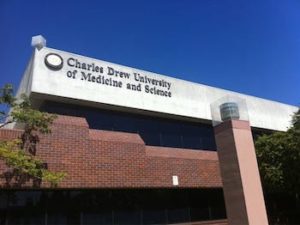
*The Charles R. Drew University of Medicine and Science was founded on this date in 1966. The Charles R. Drew Postgraduate Medical School (later Charles R. Drew University of Medicine and Science) has evolved and grown since its beginning.
Named after Dr. Charles Drew, the community's needs shape the school. Currently, the University educates health professionals with the unique skills, knowledge, and commitment needed to improve the lives and health of the medically underserved. Through innovative basic science, clinical, and health services research programs, Charles Drew University faculty and students look to address the health and social issues that have the most significant impact among inner-city and minority populations.
The College of Allied Health prepares students for careers in the health sciences allied to medicine, including medical assistants, physician assistants, pharmacy technicians, medical billing/coding specialists, and medical imaging technologists. The college offers certificate programs, associate and bachelor’s degrees, and a master’s degree in nurse-midwifery education. Students in the College of Medicine's four-year M.D. program receive their degrees through a joint training program with the UCLA School of Medicine. The program accepts approximately 24 students each year.
Drew University’s curriculum, in both colleges, focuses on giving students the skills and knowledge they need to provide care in the context of a poor, underserved, and racially and ethnically diverse population. Drew University’s faculty, staff, and students run or participate in more than 100 community outreach and service programs. These efforts are a key component of the University’s mission.
Finding new approaches to old problems associated with minority and inner-city populations is a goal of much of the research conducted on the campus, and the urgency of reaching this goal is conveyed to every trainee. In the past several years, Drew University has transitioned from a primarily clinical care focus to a more traditional academic agenda where a research enterprise enriches education and service. This transition has been accomplished by actively recruiting outstanding physicians/scientists and forming partnerships with leading research institutions such as UCLA, USC, Cedars-Sinai Medical Center, the City of Hope, and the Mayo Clinic.
The Charles R. Drew University of Medicine and Science is located in the Watts-Willowbrook section of South Central Los Angeles, directly adjacent to the King/Drew Medical Center (Directions). The 11-acre campus includes central administration, educational and learning resources, a biomedical library, basic, clinical, and population-based research facilities, and housing for postgraduate students. At present, beyond the Faculty and Drew University of Medicine and Science, students see a different future for the city.
Black American Colleges and Universities:
Profiles of Two-Year, Four-Year, & Professional Schools
by Levirn Hill, Pub., Gale Group, 1994
ISBN: 0-02-864984-2